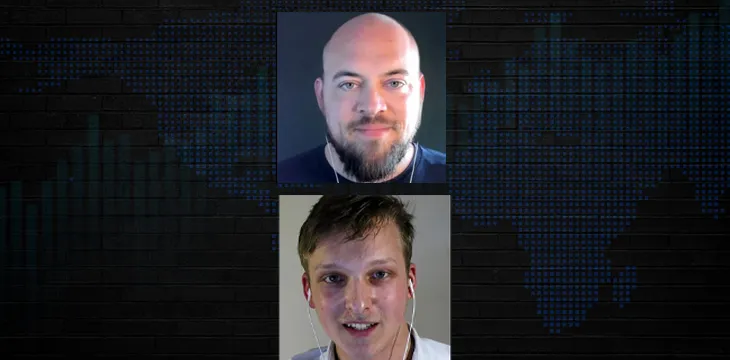|
Getting your Trinity Audio player ready...
|
The best technology will always win over time, and with its massively scaling enterprise blockchain, so will Bitcoin SV, Kurt Wuckert Jr. believes. Speaking on the Darntons podcast, Kurt shared his thoughts on Satoshi’s vision and its restoration through Bitcoin SV, why BTC has failed, the house of cards that’s the Lightning Network, why micropayments matter, and why BSV continues to be attacked so viciously by the BTC faction and their cronies.
Kurt has been in Bitcoin since 2012 and has seen it gain wide appeal, witnessed Satoshi’s vision taken off the track into what BTC is today, backed the big blocks faction during the Bitcoin Civil War, and is today the chief Bitcoin historian at CoinGeek. He also runs GorillaPool, a BSV mining pool that today holds the world record for the biggest block mined by total data and transaction count, the most profitable block ever mined and the smallest output fee ever.
“Everything you can do, or can try to do, we’re doing at GorillaPool,” Kurt noted.
Kurt revealed he had attended BTC 2022 Miami, an event that has become the Mecca for the BTC faction. People like Max Keiser, Michael Saylor, and even Peter Thiel led the crowd in the same old BTC rhetoric, “It’s BTC or nothing.”
As he found, “Nobody could even articulate what mattered outside of the valuation going up” in this year’s event. Nevertheless, he enjoyed Jordan Peterson’s presentation, which he believes was riddled with ironic references to the misguided wisdom of the crowd, a criticism of the same crowd that was cheering him on.
Kurt also talked about BTC and why it has failed so miserably. But as he told Darntons, the biggest BTC axioms and rhetoric is nothing new. In the first few days after Satoshi published the Bitcoin white paper, he was already being told that it couldn’t scale, everyone would have to run a node, and other popular rhetoric.
Over time, the Bitcoin community became divided between the big and small blockers. The civil war ensued and Satoshi’s vision was restored through Bitcoin SV. The small blockers have held onto BTC and the big money as well, with their crowning glory being the $2 trillion market cap for an industry that has thousands of projects. This, according to Kurt, is what failure looks like.
“I would argue that it’s a near-complete failure. We have not onboarded or disrupted any real industry in any significant sense because of it,” he said.
Kurt believes that Bitcoin SV will emerge as the undisputed winner of the Bitcoin Civil War because the best tech always wins over time. He drew parallels with the videotape format wars of the ‘80s between Betamax and Video Home System (VHS). While Betamax had more quality, it couldn’t accommodate a movie in one tape. VHS was cheaper to buy, had a more convenient viewing experience, and ended up winning the war because “it actually solved people’s problems.”
The biggest difference between BTC and BSV is that with the latter, you can build “in, on, above around the protocol. BSV is like a general-purpose monetary computer.” BTC is at best “a pretty bad settlement technology, or a base layer to build another redundant payments technology which is the Lightning Network,” he pointed out.
The BTC community has always touted how the network has revolutionized money by allowing users to send “a billion dollars for a five bucks.” However, this group of users wasn’t what Satoshi had in mind when he created Bitcoin. Instead, it was those who couldn’t afford the five bucks and needed a payments technology that charges fractions of a penny. This is the demographic that BSV targets through its real-time micro and nano-transactions.
Kurt also debunked Lightning Network, which the BTC community has tried to pass off as a Layer 2 on the BTC network.
“It’s not L2 at all. A Layer 2 is something that runs in the stack of a Layer 1. Lightning doesn’t work this way. Right at the base of it, calling it a Layer 2 technology is maliciously dishonest. It makes people think they are using Bitcoin while they are not,” he stated.
And while the BTC faithful has passed off Lightning Network as the solution to the scaling issues, data has proven that even they don’t believe in their own gospel as there’s more BTC on Ethereum (through Wrapped BTC) than there is on the Lightning Network.
Kurt wrapped up by explaining why there’s so much animosity towards BSV. It all started when Dr. Craig Wright decided to stand up for himself after years of being mocked and insulted. The BTC cartel decided to blacklist Bitcoin SV and delist it from their platforms, believing that this would cut Dr. Wright off at the knees. Changpeng Zhao was the first to delist BSV from Binance, and the Crypto Crime Cartel would follow suit, with Kraken and Shapeshift delisting shortly after.
For entities that have now claimed to be at the forefront of freedom by refusing to blacklist Russian users, they sure were quick to throw out an entire community just because they didn’t like one man.
Watch: CoinGeek New York panel, BSV vs. Other Blockchains: Differences that Matter for Developers & Businesses

 08-12-2025
08-12-2025 





